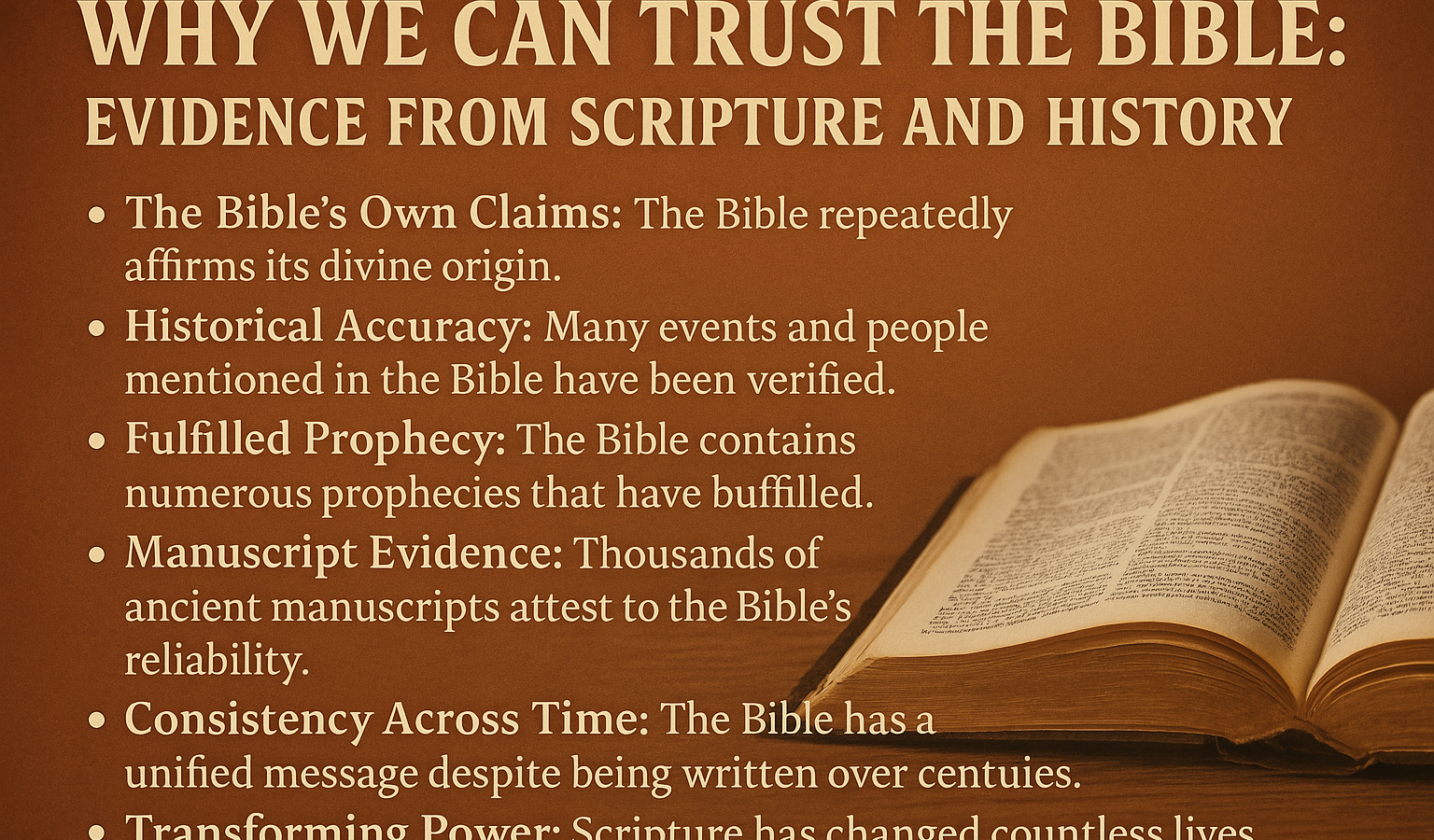The trustworthiness of the Bible can be supported by a multifaceted analysis of historical, manuscript, archaeological, and internal evidence, as well as external corroboration.
The Bible is the most influential book in history, shaping cultures, guiding faith, and transforming lives. But how do we know it is truly the Word of God? Here are key reasons why we can trust the Bible, based on historical, prophetic, and textual evidence.
1. The Bible’s Own Claims
The Bible repeatedly affirms its divine origin:
• 2 Timothy 3:16-17 – “All Scripture is God-breathed and is useful for teaching, rebuking, correcting and training in righteousness.”
How To Trust God When Life Hurts
• 2 Peter 1:21 – “For prophecy never had its origin in the human will, but prophets, though human, spoke from God as they were carried along by the Holy Spirit.”
These verses establish that Scripture is not merely human wisdom but divinely inspired.
2. Manuscript Evidence
– Quantity and Quality: The New Testament is supported by over 5,800 Greek manuscripts, far exceeding other ancient texts (e.g., Homer’s Iliad with 1,800+ copies). Early fragments like the John Rylands fragment (c. 125 AD) and Codex Sinaiticus (4th century) reduce the gap between original writings and copies.
– Old Testament Preservation: The Dead Sea Scrolls (2nd century BCE–1st century CE) confirm the remarkable consistency of the Hebrew Bible over centuries.
3. Archaeological Corroboration
– Historical Figures and Places: Discoveries like the Pilate Stone (confirming Pontius Pilate), the Tel Dan Stele (mentioning the “House of David”), and the Pool of Bethesda validate biblical accounts.
– Civilizations: The Hittites, once dismissed as mythical, were confirmed by 19th-century archaeology.
4. Historical Accuracy
The Bible aligns with historical records and archaeology. Many events, places, and people mentioned in Scripture have been verified by historians and archaeologists:
• The Hittite Empire – Once thought to be fictional, the Hittites were later confirmed through archaeological discoveries.
Lessons From The Life Of Joseph: How God Transforms Adversity
• King David’s Existence – The Tel Dan Inscription (9th century BC) refers to the “House of David,” proving his historicity.
• The Dead Sea Scrolls – Discovered in 1947, these ancient manuscripts confirm the reliability of the Old Testament.
5. Fulfilled Prophecy
– Specific Examples: Cyrus’s conquest of Babylon (Isaiah 44:28–45:1) and the Messiah’s lineage (Genesis 49:10; Micah 5:2) align with historical and New Testament accounts. Critics note debates over dating, but many prophecies (e.g., Tyre’s destruction in Ezekiel 26) predate events.
6. Eyewitness Testimony and Authorship
– New Testament Claims: Luke emphasizes careful investigation (Luke 1:1–4), John claims eyewitness status (John 21:24), and Paul’s letters (e.g., 1 Corinthians 15:6) reference living witnesses.
– Martyrdom: Early traditions suggest apostles like Peter and Paul died for their claims, underscoring their conviction (though some accounts lack contemporaneous documentation).
7. Unity and Coherence
– Diverse Authorship: Written over 1,500 years by 40+ authors, the Bible maintains a cohesive narrative of redemption. Apparent contradictions (e.g., Gospel differences) are often harmonized as complementary perspectives.
8. External Historical References
– Non-Christian Sources: Tacitus (Annals 15.44), Josephus (Antiquities 18.3.3), and Pliny the Younger corroborate Jesus’ existence, crucifixion, and early Christian practices.
9. Textual Criticism and Transmission
– Minor Variants: Over 99% of textual variants are insignificant (e.g., spelling errors). Major doctrines remain unaffected, affirming reliable transmission.
10. Survival and Impact
– Cultural Influence: The Bible’s resilience through persecution and its shaping of Western law, ethics, and art testifies to its enduring authority.
11. Consistency Across Time
Despite being written over 1,500 years by 40 different authors from various backgrounds, the Bible has a unified message: God’s redemption of humanity through Jesus Christ. This consistency across cultures, languages, and centuries is unparalleled in literature.
12. Transforming Power
Beyond historical and textual evidence, the Bible’s impact on individuals and societies is undeniable. Millions testify to how Scripture has transformed their lives, guiding them to truth, purpose, and salvation.
Addressing Counterarguments
– Miracles and Faith: While historical reliability doesn’t prove miracles, credible witnesses and consistent accounts invite consideration of supernatural claims.
– Translation Concerns: Textual criticism ensures the original message is recoverable despite minor copyist errors.
Conclusion
The Bible is trustworthy because of its historical reliability, fulfilled prophecies, manuscript evidence, consistency, and transformative power. Jesus Himself declared, “Heaven and earth will pass away, but my words will never pass away” (Matthew 24:35).
As Christians, we can confidently trust the Bible as God’s inspired Word and foundation for our faith.
Last modified: May 22, 2025

